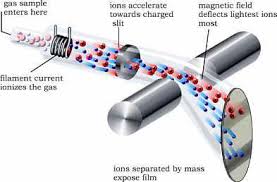We began our class today by admiring yesterday's blog, and then we were given the answers to pages 21 and 22.
1. c
2. a
3a. Na(+1) 3b. Al(+3) 3c. N(-3)
3d. F(-1) 3e. Ba(+2) 3f. Se(-2)
4. c
5. -1
6. -2
7. a
8a. BaCl2 8b. Al2O3
8c. NH4Cl 8d. Na3SO4
9. b
10. c
11. a
12. d, a, b
13. b
14. c
15. c, b, a
16. a
Atomic Mass:
Then we got back our quiz, and proceeded to talk about atomic mass. We learned that the atomic mass listed on the periodic table is the average of the most common atomic masses of an element. In order to find the atomic mass you do not weigh the atom, but instead you compare 1 atoms mass to another. In order to find this difference, you must shoot the atoms through a magnetic field, and compare how much 1 atom bends (upward or downward) to how much another atom bends. The more an atom bends, the greater the atomic mass. (Pg. 14 for help). This diagram shows the atoms in the magnetic field.
This diagram shows the atoms in the magnetic field.
We then learned how to find the average atomic mass of an element. You take the isotopes provided (ex Boron-10= boron with atom mass 10) and take the abundance in the earth, and multiply to find the average mass of boron or any element. Take number 1 on pg. 14 for example and do the following: (multiplication sign is *)
#1 Pg. 14:
.198*10.1+.802*11= 10.8 amu
- .198 and .802 represent the abundance on earth of that isotope, while 10.1 and 11 represent the masses.
-when doing this you label the atomic mass as amu
If you are given: Find which isotope of element y is more present in the environment using the periodic table. Then you find which atomic mass the element is closest to, and that is the most common in nature.
ex: Boron's atomic is 10.81 because 10.81 rounds to 11, you know boron-11 is more
common in nature
Math:
Today, we also briefly talked about how to do unit conversions. You use the Factor Label Method.
This rule is based off the idea that if a=b, then a/b=1.
ex: find the number of centimeters in 1 mile
Steps:
1. you begin by putting 1mile over 1
2. you cancel out miles by putting 5280ft over 1miles
3. you cancel out feet by putting 12in over 1ft
4. you cancel out inches by putting 2.58cm over 1in
A= 160934 cm/miles (centimeters per mile)
For help on factor label method go to: http://library.thinkquest.org/2923/basic.html ,
HW:
-webassign
No comments:
Post a Comment
Note: Only a member of this blog may post a comment.